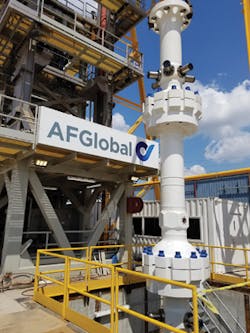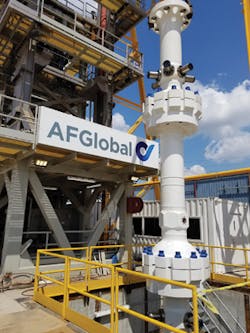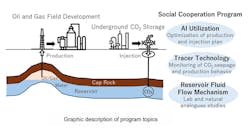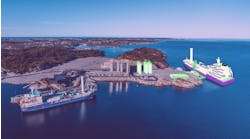Industry advances managed pressure drilling solutions
Automated, integrated systems aim for greater efficiency
Bruce Beaubouef, Managing Editor
Oilfield equipmentproviders and downhole service firms are raising the bar for managed pressure drilling (MPD) technologies and systems. These new technologies will be of considerable interest to offshore operators and drilling contractors as they face increasingly challenging deepwater reservoirs.
MPD systems allow drilling operations to continue “at balance” in oil and gas plays where primary well control cannot meet the needs of pore pressures due to weak fracture gradients in the well profile. And, operators and drilling contractors are increasingly looking for MPD systems that will enable them to access reservoirs where conventional, hydrostatically over-balanced drilling methods encounter problems; and in drilling plays where the margin between pore pressure and fracture gradient is narrow.
Narrow pressure windows are increasingly common when drilling in mature deepwater fields, posing a formidable challenge. This condition is characterized by a small difference between the pore pressure – the fluid pressure inside rock pores pushing out – and the fracture gradient – the fluid pressure needed outside the rock to fracture it. When using conventional drilling techniques, a small change in wellbore pressure can represent the difference between profitable success or costly failure. Common risks include borehole instability, pressure cycles that require breakouts, downhole mud losses, surge and swab effects, and even kicks. When market conditions are difficult, the thin margin for error means the risks are even more pronounced.
AFGlobal’s MPD test rig is said to be capable of testing equipment to all requirements of API 16RCD. (Courtesy AFGlobal)
Fortunately, narrow pressure windows can be addressed using MPD techniques to precisely control the annular pressure throughout the wellbore. MPD is basically a tool to manage equivalent circulating density. It has revolutionized drilling in the major deepwater and ultra-deepwater areas, such as Brazil, West Africa, the North Sea, and the Gulf of Mexico, where it has been used for more than 10 years. Coupled with early kick detection, the technique helps operators avoid issues caused by narrow pressure windows.
Several new technologies have been introduced to the market in recent months to address these challenges. Last May, Halliburton announced its GeoBalance automated MPD system, which it described as a comprehensive suite of software and hardware that enables automated managed pressure control, from drilling to completion. Halliburton says that the system combines automatic chokes, rig pump diverters, flow metering, and control algorithms with hydraulics modeling to provide pressure control at discrete points throughout well construction. The GeoBalance system won an OTC Spotlight Award in 2018.
Elsewhere, AFGlobal has introduced an array of new technologies and testing facilities that are expected to bolster its MPD portfolio and capabilities. In 2018, the company developed a test rig that is designed for testing MPD equipment, while mimicking actual drilling conditions, to better understand equipment performance.
AFGlobal also launched its proprietary Active Control Device (ACD), which it says is the industry’s first purpose-built marine control device, replacing the traditional rotating control device (RCD) for deepwater applications. The company says that the ACD provides the prerequisite seal and diversion of annular wellbore returns using a novel, non-rotating seal. Using proprietary sealing elements, the ACD is designed to eliminate bearings and rotating components that can be a regular source of maintenance and failures in traditional RCDs.
“We are leveraging our manufacturing experience and deployment of more than 40 MPD-ready systems to drive the next phase of MPD – active pressure management,” said Mark Mitchell, President of Oil & Gas at AFGlobal. “Working closely with all the stakeholders, we have designed, built, and installed the industry-leading equipment that is enabling a global fleet of MPD ready rigs.”
The development of these new technologies followed a contract award from Noble Corp. in 2017 which called upon AFGlobal to supply an integrated deepwater MPD system to vessels in the Noble Corp. rig fleet. Scott Marks, senior vice president of Engineering at Noble Corp., said: “The addition of MPD systems to our rig fleet will provide a valuable competitive advantage with an expected higher level of safety and performance.”
Weatherford is working to implement a standardized set of MPD equipment that will allow a rig to quickly address any number of drilling and well control issues – kicks, lost circulation events or riser gas – whenever they might arise. Typical equipment includes a rotating control device (RCD) to keep the well closed while diverting annular fluids out of the well; Microflux, an MPD control system used to detect and control minute downhole influxes and losses; a Coriolis mass-flow meter to capture mass and volume flow, mud weight/fluid density and temperature from returning annular fluids; hydraulic power units; and associated valves and hoses. An intelligent control unit and data acquisition system ties everything together by analyzing the system data, pinpointing the source and cause of a fluid influx or loss and transmitting the information to operation centers on location and onshore.
NOV says that its MPowerD systems combine MPD components into scalable, fit-for-purpose packages that provide safe, efficient drilling in closed-loop applications. From chokes and manifolds to rotating control devices and control systems, the company says that its MPD systems have been fully integrated into the drilling rig for land, shelf, and deepwater segments, as well as standalone systems that are compatible across multiple segments.
Schlumberger has introduced what it describes as the industry’s first integrated MPD solution – designed to be an all-OEM, reservoir-to-flare-stack deepwater MPD system, the company said. The integrated MPD system would enable operators to minimize rig footprint while maximizing drilling efficiency and versatility by obtaining design and engineering, manufacturing, system integration, well engineering, and onsite well delivery services from a single supplier. The integrated MPD solution won an OTC Spotlight Award in 2017.
On some drilling campaigns, MPD technologies are being combined with other systems to enhance drilling and completion efficiency. On a recent job in the Asia/Pacific region, Shell identified the need for an MPD/managed pressure cementing (MPC) solution on two water injection wells. The solution was needed to maintain constant bottomhole pressure while drilling in a narrow pressure margin.
The MPD/MPC control system was configured to receive data from several ancillary sources for the best possible pressure control downhole. MPC technology was successfully utilized to cement the liners on both wells in order to maintain equivalent circulating density above the sand stringer pore pressure, while avoiding losses to weak shale/faulted zones. GB Setpoint, the Halliburton real-time hydraulics model, was an important asset during both the MPD and MPC operations. By incorporating real-time data, tracking multiple fluids in the wellbore and accounting for surge and swab while running the liner, the crew was able to successfully navigate a narrow window within the target BHP.
Halliburton helped the operator avoid two weeks of NPT related to borehole stability, reservoir influxes and losses, controlling the BHP at the critical point in the well during drilling operations, including tripping and running and cementing the liner. This operation for Shell in Asia/Pacific is expected to pave the way for similar operations in this region and beyond.
Faced with the challenges that deepwater drilling and unconventional reservoirs can bring, the industry is still finding its path forward on active pressure management techniques and technologies. To date, MPD has been a discrete process used in response to specific challenges, such as drilling within narrow pore pressure-fracture gradient windows. But the closed-loop circulating system that enables MPD facilitates many applications for understanding and affecting wellbore pressure. Among them are well control, pressure management, riser gas handling, mud optimization, ROP enhancement, dynamic formation integrity testing, and cementing, to name just a few. Whether and to what extent operators, drilling contractors, service firms and OEMs optimize that path forward by finding common ground on the design and desirability of these systems is the next big question in offshore drilling and completion. •




